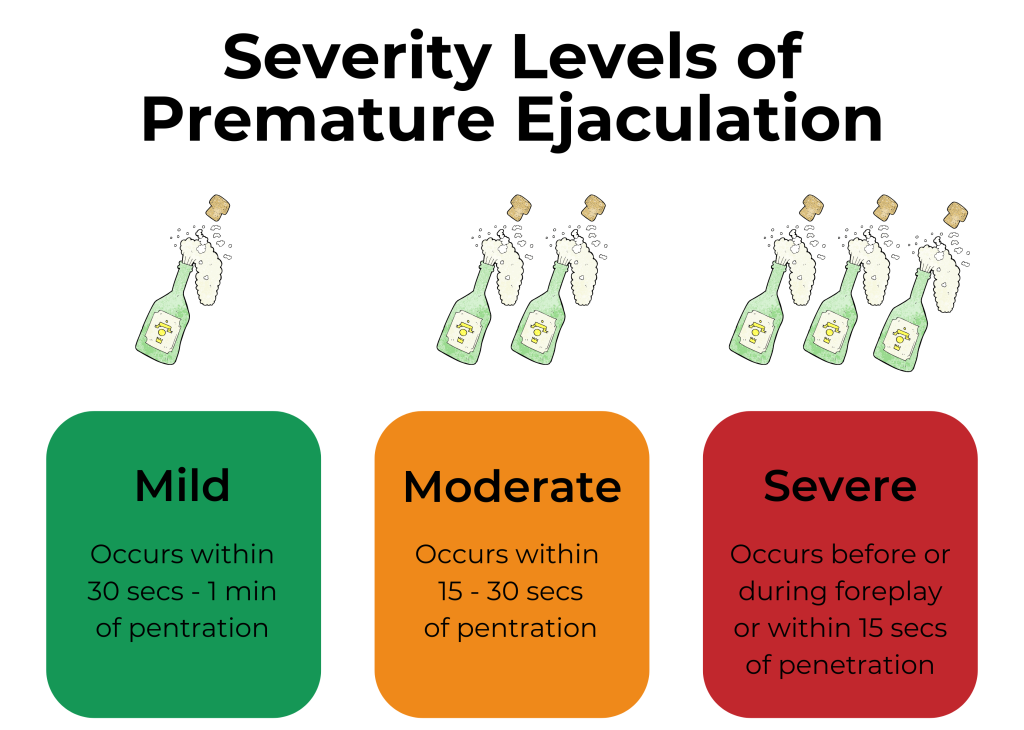Understanding Premature Ejaculation: Causes, Symptoms & Treatments
Premature ejaculation (PE) stands as a prevalent sexual issue, impacting around 21–31% of adult males in Australia, regardless of their age, marital status, or ethnic background.
This sexual condition often goes unnoticed and untreated due to the shame and diminished self-worth felt by patients. Premature ejaculation can profoundly impact the well-being of both the individual experiencing it and their sexual partner. It may result in psychological distress, lowered self-esteem, anxiety, erectile dysfunction, decreased libido, and strained interpersonal connections.
As stated by the Australian Family Physician (AFP), Premature Ejaculation is characterised as the inability to manage or postpone ejaculation, leading to dissatisfaction or distress for the individual.
What Causes Premature Ejaculation (PE)?
Cleveland Clinic identifies that premature ejaculation primarily stems from four factors: physical, chemical, and emotional/psychological.
However, it’s important to acknowledge that the precise cause of premature ejaculation remains uncertain. Nevertheless, healthcare professionals understand that premature ejaculation results from a multifaceted interplay of physical, psychological, and biological factors.
- An underlying diagnosis of erectile dysfunction.
- An issue with oxytocin levels, a hormone that influences male sexual function. Other hormones affecting sexual function include luteinizing hormone (LH), prolactin, and thyroid stimulating hormone (TSH).
- Low levels of serotonin or dopamine, neurotransmitters in the brain crucial for sexual desire and arousal.
- Increased sensitivity of the penis to stimulation.
- Performance Anxiety (stemming from nervousness with a new partner, apprehension after a prolonged period of abstinence, diminished confidence, guilt, excessive excitement, or other causes).
- Stress.
- Difficulties in relationships (such as infidelity or persistent disagreements).
- Depression.
Symptom Classification of PE
The fundamental symptom criteria for diagnosing premature ejaculation include the duration of time before ejaculation, the incapacity to postpone ejaculation, and the presence of adverse effects resulting from premature ejaculation.
According to the International Society of Sexual Medicine (ISSM), premature ejaculation is categorised into two types: Lifelong (also known as Primary PE) or Acquired (referred to as Secondary PE).
- Lifelong Premature Ejaculation (Primary PE) occurs when the individual starts engaging in sexual activity. Primary PE may persist from the initial sexual encounter and is frequently attributed to conditioning, upbringing, or an early traumatic sexual experience.
- Acquired Premature Ejaculation (Secondary PE) emerges gradually after a period of relatively normal sexual functioning.
Symptom Severity Levels of PE
The severity of symptoms of Premature Ejaculation varies depending on when the ejaculation occurs during sexual activity. As outlined by Crowdis, Leslie & Nazir (2023), Premature Ejaculation severity can be categorised into three levels:
- Mild – occurs within approximately 30 seconds to 1 minute of vaginal penetration.
- Moderate – occurs within approximately 15 to 30 seconds of vaginal penetration.
- Severe – occurs before or during foreplay, at the start of sexual activity, or within approximately 15 seconds of vaginal penetration.

Management & Treatment for Premature Ejaculation
Numerous treatment options exist for Premature Ejaculation, which vary based on its underlying cause. These options encompass behavioural therapy, counselling, and medications.
Behavioural Therapy:
Entails experimenting with various techniques aimed at delaying orgasm. Its objective is to educate individuals on how to regulate their body and emotions.
- Start and Stop – With this technique, you or your partner stimulates your penis close to the point of orgasm then stops the stimulation for about 30 seconds until you regain control of your response.
- Squeeze Therapy – With this technique, you or your partner stimulates your penis close to the point of orgasm then gently squeezes the head of your penis for about 30 seconds so that you begin to lose your erection.
- Distracted Thinking – With this technique, the idea is to focus your attention on ordinary nonsexual things while you’re being sexually stimulated. Naming sequences are a good way to focus your attention.
Counselling:
If psychological, emotional, or relationship factors such as performance anxiety, depression, stress, guilt, or relationship difficulties are contributing to your premature ejaculation, consider consulting a psychologist, psychiatrist, couples therapist, or sex therapist for assistance.
- Antidepressants, particularly selective serotonin reuptake inhibitors such as citalopram (Celexa®), escitalopram (Lexapro®), fluoxetine (Prozac®), paroxetine (Paxil®), and sertraline (Zoloft®), as well as the tricyclic antidepressant clomipramine (Anafranil®), have been found effective in prolonging the time to ejaculation in cases of premature ejaculation.
- Anesthetic (numbing) creams and sprays applied to the head and shaft of the penis is another medication option to delay ejaculation.
- Erectile Dysfunction medications, such as sildenafil (Viagra®), Tadalafil (Cialis®), Vardenafil (Levitra®), and Avanafil (Stendra®).
Book a FREE appointment
One of our Patient Care Coordinators will contact you to discuss tailored treatment options.
This booking is for informational purposes only and does not constitute medical advice. In case of a medical emergency, please call your local emergency number immediately. By submitting this booking, you consent to Holmen’s Health collecting and storing your personal information to provide you with the best possible care. You also confirm that you have read and agreed to our Terms & Conditions and Privacy Policy.
- https://www.racgp.org.au/afp/2015/october/premature-ejaculation-a-clinical-review-for-the-ge
- https://www.issm.info/
- https://www.ncbi.nlm.nih.gov/books/NBK546701/
- https://my.clevelandclinic.org/health/diseases/15627-premature-ejaculation
- https://www.mayoclinic.org/diseases-conditions/premature-ejaculation/symptoms-causes/syc-20354900

